Are you tired of trying to decipher the true value of your clients? Picture this: you run a successful business, but when it comes to determining how much revenue each client brings in, you’re left scratching your head. It’s frustrating, isn’t it?
But fear not, because in this comprehensive guide, we’ll unravel the mystery behind ARPU and show you how to accurately measure and interpret this crucial metric. So, if you want to uncover the hidden potential in your user base and optimize your revenue streams, you’ve come to the right place.
Understanding ARPU
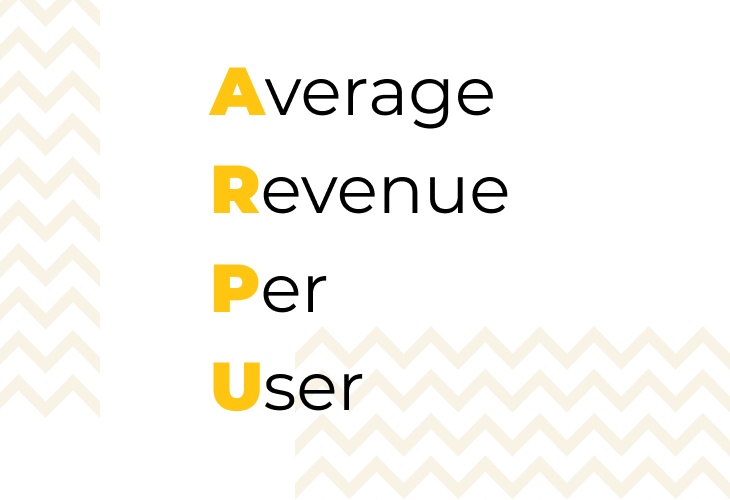
ARPU, short for Average Revenue Per User, is an important metric used by businesses to measure the average revenue generated per user or customer. It provides valuable insights into the financial performance and profitability of a company. Calculating and interpreting ARPU correctly is crucial for evaluating business strategies, identifying growth opportunities, and benchmarking against industry standards.
What is ARPU?
ARPU is a key performance indicator (KPI) that helps businesses analyze their revenue streams and assess the value each user or customer brings to the company. It is calculated by dividing the total revenue generated in a specific period by the number of active users or customers during that same period. The result is an average figure that represents the revenue generated per user.
The importance of ARPU
ARPU provides valuable information about the revenue potential and profitability of a company’s customer base. By understanding this metric, businesses can identify segments of users or customers that generate higher revenues and focus their efforts on attracting and retaining these valuable customers.
ARPU also allows businesses to evaluate the success of pricing strategies, product offerings, and marketing campaigns. A higher ARPU indicates a greater ability to monetize customers and can be an indicator of business growth and financial health.
Calculating ARPU
To calculate ARPU, follow these steps:
- Determine the time period for which you want to calculate ARPU (e.g., monthly, quarterly, annually).
- Calculate the total revenue generated during that period.
- Count the number of active users or customers during the same period.
- Divide the total revenue by the number of users or customers to get the average revenue per user.
ARPU = Total Revenue / Number of Active Users (or Customers)
Key components of ARPU

ARPU is a vital metric in the telecommunications and subscription-based industries. To calculate ARPU accurately, it is essential to understand the key components and factors that affect it.
Here are the main elements to consider when analyzing ARPU:
- Revenue: This refers to the total income generated from all sources, such as subscriptions, sales, or fees, within a specific period. It includes both recurring and one-time revenues.
- Total Users: Calculate the total number of active users or customers during the given period. Consider both new and existing users.
- Average Calculation Period: Determine the appropriate timeframe for calculating ARPU. This could be a month, quarter, or year, depending on your business model and industry.
- Exclusions: Exclude any non-recurring revenues or users who do not contribute to regular income streams. For instance, if there are one-time purchases or temporary subscriptions, they may skew the ARPU calculation.
- External factors: Take into account external influences that may impact ARPU. Factors such as pricing changes, discounts, promotions, or market trends can affect the average revenue generated per user.
💡 key Takeaway: A thorough understanding of the key components of ARPU and their impact is essential for accurately measuring and interpreting this vital metric. Regular monitoring and analysis of ARPU can provide valuable insights into business performance and customer behavior.
Methods to calculate ARPU
Calculating ARPU is essential for businesses to assess the financial performance and effectiveness of their revenue generation strategies. Here are three commonly used methods to calculate ARPU:
Method 1: simple ARPU calculation
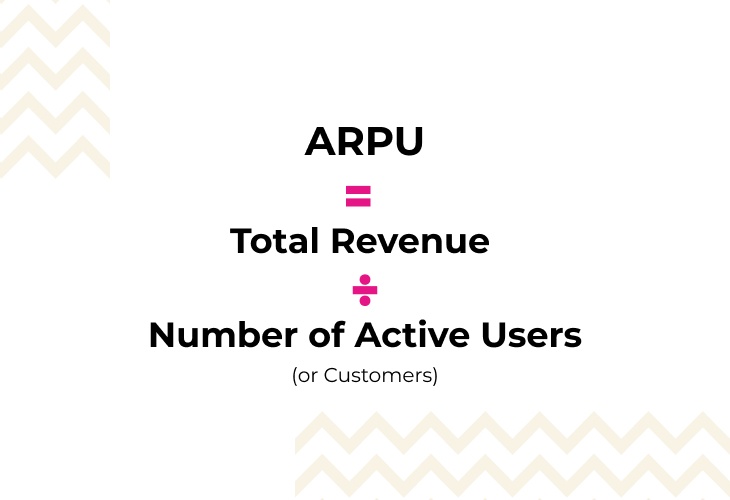
The simplest method to calculate ARPU is by dividing the total revenue generated within a specific period by the total number of active users during that same period. The formula is as follows:
ARPU = Total Revenue / Total Active Users
For example, if a company generates $100,000 in revenue and has 1,000 active users in a month, the ARPU would be $100.
Method 2: advanced ARPU calculation
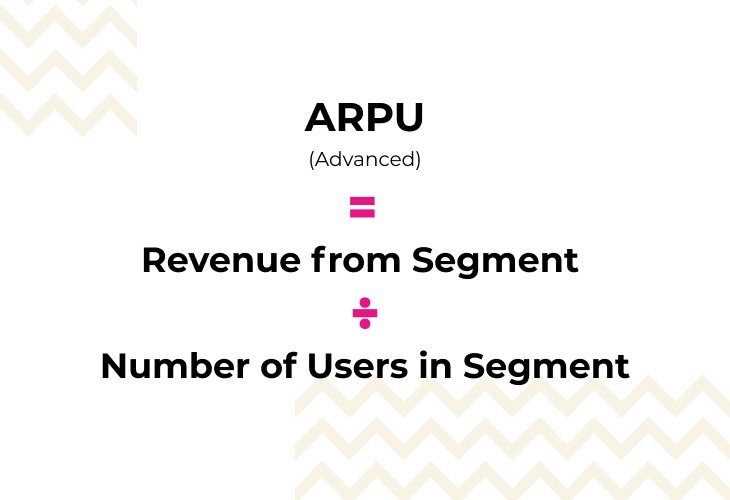
The advanced method allows businesses to segment their user base for a more detailed analysis. By dividing the revenue from each segment by the corresponding number of users in that segment, businesses can calculate ARPU for different customer groups. This method provides insights into the profitability of each segment and helps identify opportunities for growth.
For instance, a video streaming service may calculate ARPU separately for basic users and premium subscribers. The formula for advanced ARPU calculation is:
ARPU = Revenue from Segment / Number of Users in Segment
Method 3: weighted ARPU calculation
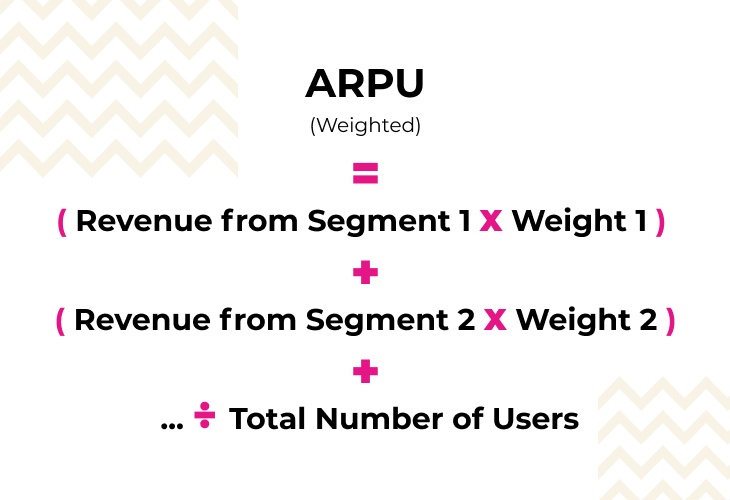
Weighted ARPU takes into account the varying revenue contributions from different user segments. This method assigns specific weights to each segment based on their importance or revenue generation potential. The formula is as follows:
Weighted ARPU = (Revenue from Segment 1 * Weight 1) + (Revenue from Segment 2 * Weight 2) + … / Total Number of Users
Weighted ARPU provides a more accurate representation of the revenue generated by different user groups and helps prioritize marketing and growth strategies.
💡 key takeaway: Calculating ARPU is crucial for businesses to evaluate their revenue generation strategies. There are three main methods to calculate ARPU: simple ARPU calculation, advanced ARPU calculation for segmented analysis, and weighted ARPU calculation. Each method provides valuable insights for making informed decisions and driving business growth.
Interpretation of ARPU
Interpreting ARPU trends can help businesses understand their financial performance, customer behavior, and the effectiveness of their pricing strategies. Here, we will delve into the significance of ARPU trends and how to interpret them.
Comparing ARPU to industry benchmarks
Understanding how your ARPU compares to industry benchmarks is essential for benchmarking your business’s performance. It allows you to assess whether your ARPU is above or below average and can help you identify areas for improvement or potential opportunities.
Analyzing ARPU trends over time
Tracking ARPU over time can provide valuable insights into your business’s growth and customer loyalty. Positive trends may indicate a successful acquisition and retention strategy, while stagnant or declining trends might warrant further investigation into pricing, customer satisfaction, or market changes.
Segmenting ARPU by customer groups
To gain a deeper understanding of your customer base, you can segment ARPU based on different customer groups. By analyzing ARPU variation among segments, you can identify high-value customer groups and tailor your marketing and pricing strategies accordingly.
Comparing ARPU across different products or services:
If your business offers multiple products or services, comparing ARPU for each offering can reveal the relative success or profitability of each. It can help you allocate resources effectively, optimize pricing strategies, and identify any underperforming areas.
💡 key takeaway: Interpreting ARPU trends is crucial for understanding your business’s financial performance, customer behavior, and pricing strategies. Comparing ARPU to industry benchmarks, analyzing trends over time, segmenting customers, and comparing ARPU across different products or services can help in analyzing the success of your products or services.
ARPU optimization strategies
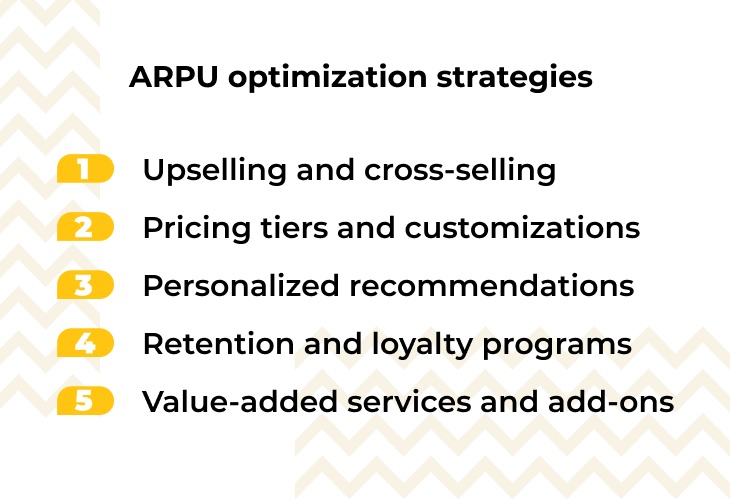
When it comes to maximizing your average revenue per user (ARPU), there are several effective strategies that can help you increase this key metric. Implementing these strategies can not only boost your revenue, but also enhance customer satisfaction and loyalty. Below, we have outlined five ARPU optimization strategies that you can incorporate into your business model:
- Upselling and cross-selling opportunities
One way to optimize your ARPU is by identifying upselling and cross-selling opportunities within your customer base. By offering additional products or services that complement what your customers are already using, you can increase their average spending per user. For example, if you have a subscription-based business, you can offer premium packages with enhanced features or bundle deals to upgrade your customers’ experience.
- Pricing tiers and customization
Another effective strategy to optimize ARPU is by offering different pricing tiers and customization options. This allows you to cater to different customer segments with varying needs and budgets. By providing flexibility in pricing and services, you can capture a wider range of customers and encourage them to spend more based on the value they perceive.
- Personalized recommendations
Personalization plays a significant role in optimizing ARPU. Utilize customer data and analytics to create personalized recommendations for your users. By tailoring your offerings and promotions to individual preferences and behaviors, you can effectively drive higher spending and encourage repeat purchases.
- Retention and loyalty programs
Retaining your existing customers and fostering their loyalty is crucial for ARPU optimization. Implement retention and loyalty programs to reward recurring customers and encourage them to continue their relationship with your brand. This can be achieved through loyalty points, exclusive discounts, or special access to new product releases.
- Value-added services and add-ons
Offering value-added services and add-ons is another effective strategy for ARPU optimization. Identify additional services or features that can complement your core offering and provide enhanced value to your users. If you can’t develop these features or services in-house, consider outsourcing software development. By providing these optional extras, you can increase the overall spending of your customers as they perceive the benefits of these added services.
💡 key takeaway: Implementing effective ARPU optimization strategies such as upselling, cross-selling, personalized recommendations, and retention programs can help increase your average revenue per user. By tailoring your offerings, pricing, and loyalty initiatives, you can maximize customer spending and enhance overall profitability.
Challenges in ARPU analysis
Calculating and interpreting ARPU can provide valuable insights into the financial performance of a business. However, there are several challenges and limitations that need to be considered when conducting ARPU analysis.
- Inaccurate data: One of the significant challenges in ARPU analysis is the availability and accuracy of the data. Companies may face difficulties in accurately tracking and attributing revenues to individual users, especially in complex business models or industries where revenue streams come from multiple sources.
- Intangible factors: ARPU analysis often fails to account for intangible factors that can impact revenue. For instance, the quality of customer service, brand reputation, or user experience may influence customer retention and revenue generation, yet these factors are not directly reflected in ARPU calculations.
- Cross-border complexities: Companies with global operations often face challenges in ARPU analysis due to differences in currency exchange rates, local market dynamics, and regulatory frameworks. These complexities make it harder to compare ARPU figures across different regions and accurately assess the true financial performance.
- Seasonality and trends: ARPU calculations may be influenced by seasonal fluctuations or trends within specific industries. For example, the holiday season can lead to higher revenues for e-commerce businesses, skewing the ARPU analysis if not adjusted for seasonality.
- Variations in user base: ARPU analysis becomes more complex when dealing with diverse user bases, such as freemium, premium, or subscriber models. Each user segment can have different spending patterns, making it necessary to segment ARPU analysis accordingly for a more accurate interpretation.
- Competitive landscape: ARPU analysis should not be considered in isolation but should also consider the competitive landscape within the industry. Comparing ARPU figures with industry benchmarks or competitors’ performance can provide context and help identify areas of improvement or potential risks.
- External factors: Finally, external factors such as economic conditions, technological advancements, or shifts in consumer behavior can impact ARPU calculations. It is crucial to be aware of these external influences and consider them when interpreting ARPU figures.
Use ARPU to propel your business
Average Revenue Per User (ARPU) is an important metric for ecommerce businesses. It shows how much money an individual user is generating for the company. There are a few ways to calculate ARPU. The most common method is to divide total revenue by the number of users. You can also calculate ARPU by dividing total revenue by the number of unique visitors. The metric is useful for determining the best way to target your marketing efforts. You can also use ARPU to calculate the profitability of your business.
Now that you’re equipped with the facts about ARPU, you can start using this metric to boost your business’ bottom line. Good luck!
FAQ
What are some examples of ARPU calculations?
- ARPU can be calculated by dividing total revenue by the number of users.
- ARPU can also be calculated by dividing total revenue by the average number of interactions per user.
- Finally, ARPU can be calculated by dividing total revenue by the average value of transactions per user.
What is the ARPU growth rate?
The ARPU growth rate is the average annual percent change in ARPU over a specified period of time.



























